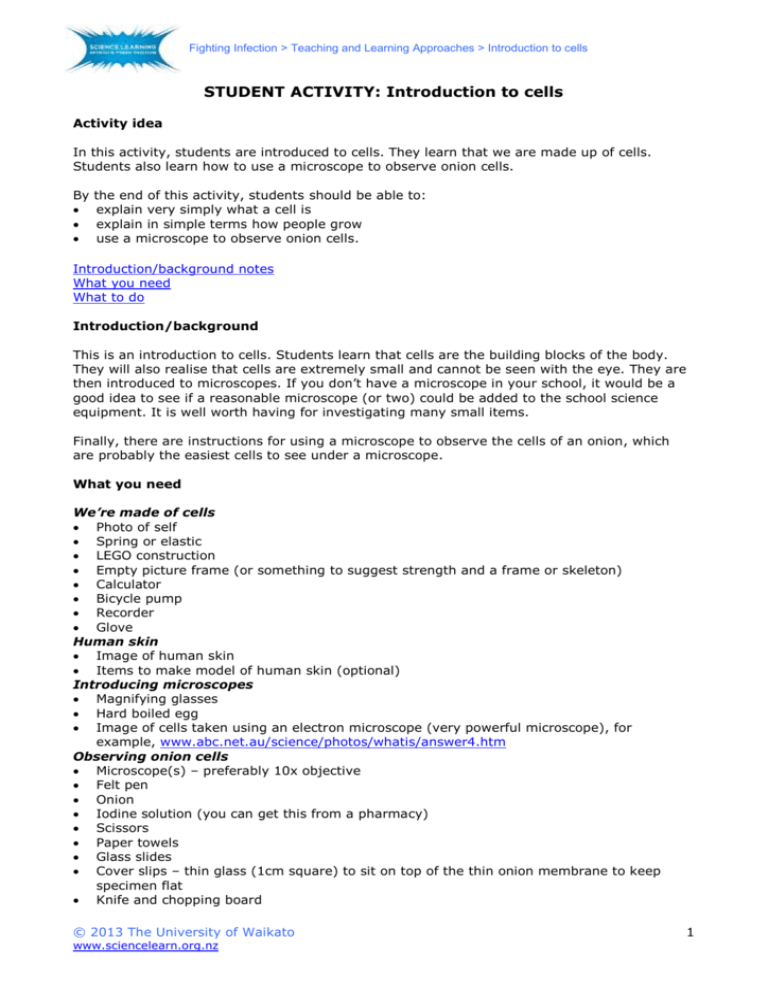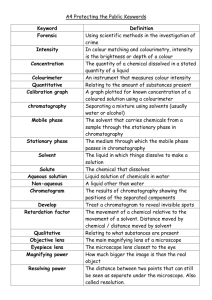Introduction to cells
advertisement

Fighting Infection > Teaching and Learning Approaches > Introduction to cells STUDENT ACTIVITY: Introduction to cells Activity idea In this activity, students are introduced to cells. They learn that we are made up of cells. Students also learn how to use a microscope to observe onion cells. By the end of this activity, students should be able to: explain very simply what a cell is explain in simple terms how people grow use a microscope to observe onion cells. Introduction/background notes What you need What to do Introduction/background This is an introduction to cells. Students learn that cells are the building blocks of the body. They will also realise that cells are extremely small and cannot be seen with the eye. They are then introduced to microscopes. If you don’t have a microscope in your school, it would be a good idea to see if a reasonable microscope (or two) could be added to the school science equipment. It is well worth having for investigating many small items. Finally, there are instructions for using a microscope to observe the cells of an onion, which are probably the easiest cells to see under a microscope. What you need We’re made of cells Photo of self Spring or elastic LEGO construction Empty picture frame (or something to suggest strength and a frame or skeleton) Calculator Bicycle pump Recorder Glove Human skin Image of human skin Items to make model of human skin (optional) Introducing microscopes Magnifying glasses Hard boiled egg Image of cells taken using an electron microscope (very powerful microscope), for example, www.abc.net.au/science/photos/whatis/answer4.htm Observing onion cells Microscope(s) – preferably 10x objective Felt pen Onion Iodine solution (you can get this from a pharmacy) Scissors Paper towels Glass slides Cover slips – thin glass (1cm square) to sit on top of the thin onion membrane to keep specimen flat Knife and chopping board © 2013 The University of Waikato www.sciencelearn.org.nz 1 Fighting Infection > Teaching and Learning Approaches > Introduction to cells What to do We’re made of cells 1. Hold up a photo of self as a baby and ask: Who is this? How did I get to adult size from this? 2. Show a spring or elastic: Stretching? 3. Show a LEGO construction: If I want to make a bigger LEGO model, what is required? (More LEGO bricks.) 4. Talk about growing living things requiring more ‘bricks’ but we call them cells. Talk about all living things being made up of cells – humans, trees, animals. Cells are very small and can’t be seen. A human body has 1013 cells. (Draw as 10,000,000,000,000.) A drop of blood has a similar number of cells as people living in New Zealand (millions). 5. Ask for 5 volunteers: 1 to hold up a picture frame (representing the frame or skeleton of a person). 1 to hold a calculator above the frame (representing the brain of a person). 1 to hold a bicycle pump mid-frame (representing the heart of a person). 1 to hold a recorder near the top of the frame (representing the vocal cords of a person). 1 to hold a glove at the side of the frame (representing someone’s hand). 6. Ask “What is represented here?” (A body – skeleton, brain, heart, vocal cords, hand.) 7. Explain that all these parts of the body are made up of cells, but they have different jobs. We have muscle cells, skin cells, bone cells etc. Some of the cells are round balls, some are block shape, others are very long, depending on the type – muscle cells, nerve cells. Human skin is made up of different cells working together to protect your muscles, heart and so on from damage. Human skin 8. (Optional) Read up about skin in library books or on the internet, look at some images of skin and make your own model. (Top layer = epidermal cells that are dead and flake off, like playing cards, while below there are column-like cells that are tightly joined together to protect the inner tissues. Hair cells line pockets in the skin, with hair growing out of the skin. There are sweat glands that help to cool the skin.) Introducing microscopes 9. Show a magnifying glass and explain that, to be able to see cells, we need to use a machine called a microscope, which is really a very fancy magnifying glass. 10. Explain that some microscopes look down and see the outside of a cell. Show a hard boiled egg and look through magnifying glass at it – young children might hold up their hand and look through a circle formed by thumb and finger to see the egg. 11. Explain that other microscopes look at the inside of cells and help us understand how a cell works. Crack open the hard boiled egg and cut through. Show the inside of the egg. 12. Show a photo of cells using a scanning electron microscope. Observing onion cells © 2013 The University of Waikato www.sciencelearn.org.nz 2 Fighting Infection > Teaching and Learning Approaches > Introduction to cells 13. Cut an onion into small segments and peel apart the layers of one piece. 14. Peel off the transparent membrane from the underside of one layer (use tweezers, or it may come off with a fingernail). Cut this membrane piece to less than 1cm square – if it is too big, it will not lie flat under the coverslip. 15. Carefully lay the membrane flat on the surface of a clean glass slide and add one drop of iodine. (Be careful – iodine will stain your skin and clothes.) 16. Hold a thin coverslip so that one edge is resting on the slide. Gently lower the coverslip (it may be easier to use a pin or toothpick to lower the coverslip). Try to avoid making air bubbles – this may be easier if the original edge of the coverslip is sitting in the dye solution. 17. Set up the microscope, with the power on and the lowest power objective lens (shortest tube) aligned. It may help to focus if you mark a dummy slide with felt pen and focus on the ink on the slide. 18. Put the onion skin slide onto the stage of the microscope. 19. Look through the eyepiece lens and focus the microscope. Only turn the focusing knob so that the objective lens moves upwards. If you need to move the objective lens down towards the microscope stage, observe from the side until the end of the lens is just above the cover slip. This is to avoid damaging the lens by cracking the coverslip. 20. Swap the objective lens for a high-powered one (if the slide is in focus, it ought to be possible to turn the objective lens around) so that you can see the cells at a greater magnification. 21. Observe the cells and the nucleus. 22. This website has some useful photos and also suggests it would be possible to examine banana cells: www.cccmkc.edu.hk/~sbjbiology/CERT%20BIO/The%20cell/Microscope%20and%20onion%20cells.htm © 2013 The University of Waikato www.sciencelearn.org.nz 3







